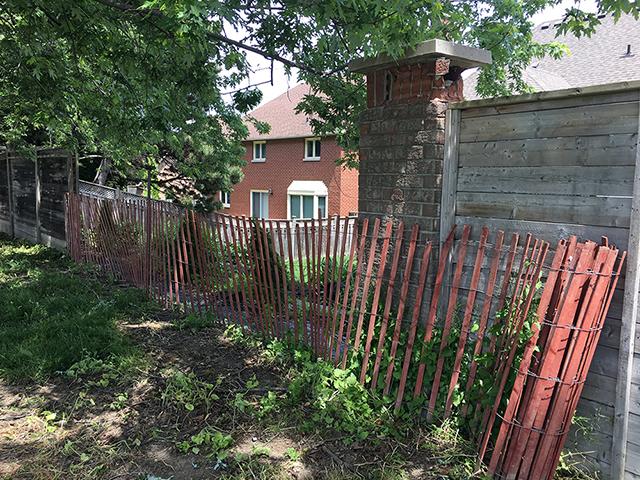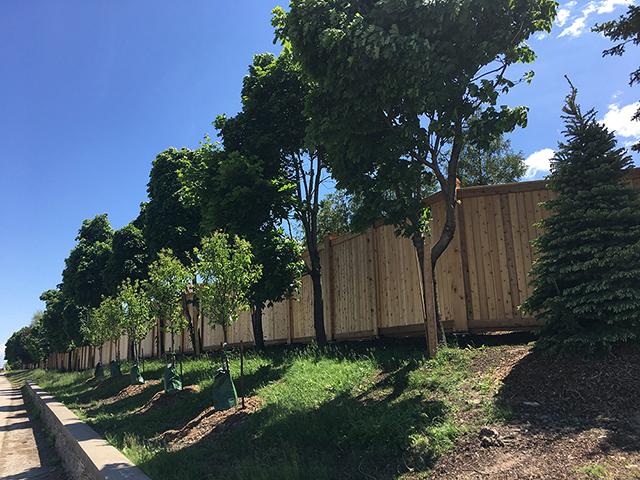Private Noise Wall Conversion Program
Privately-owned noise walls along Regional roads are built to lower sound levels in backyards. A noise wall must be continuous and solid with no gaps or gates.
As part of the Private Noise Wall Conversion Program, we’re rebuilding and relocating private, pre-selected noise walls that are adjacent to a Regional road.
Private noise wall conversion factors
The Region will inspect all private noise walls every 3 years.
Replacement of a private noise wall is based on several factors, including:
- How safe it is to the public.
- How well it is reducing sound levels.
- How stable and structurally sound it is.
- Where it is located. The private noise wall must be backing or siding onto a Regional road. Homes fronting a Regional road do not qualify for the conversion program.
During a visual inspection, the noise walls will be rated according to their condition. A wall’s rating helps us determine when it should be converted.
Other structures such as privacy fences and chain link fences do not qualify for the conversion program.
Construction and costs
If a noise wall conversion is happening in your neighborhood, we’ll tell you at least one year before the construction date.
Generally, we will be replacing entire blocks or corridors at a time.
We’ll also try to coordinate the noise wall conversion with other road work taking place in your area.
If a noise wall on private property has not been converted, the property owners must keep covering the cost of the wall’s maintenance and repairs.
Once conversion has taken place, the new noise wall will become a Regional asset and the Region will pay for any maintenance and repairs to the new noise wall.
Noise wall replacement materials
The Region is considering cedar wood or concrete composite panels as replacement materials.
We’ll determine the material type based on design standards and other environmental factors. For example, we would consider wood over concrete to avoid cutting down trees where possible.
Communication to the homeowner
We will be responsible for providing all general communication to the homeowners which includes Permission to Enter notifications prior to construction of the noise wall.
Applying for a noise wall upgrade
The Noise Wall Conversion Program does not include replacement of deteriorating privacy fences; however, homeowners can apply for a noise wall upgrade as part of our Local Improvement Program.
To determine eligibility, the Region will conduct a noise study along the affected stretch of the existing wall. This study will analyze daytime noise levels to assess if the noise levels are above 60 dBA.
If the stretch qualifies for a noise wall upgrade, the program will issue a petition to determine interest for a noise wall placement. To be successful, a petition requires that at least 3 properties benefit from the new noise wall being installed and that at least 2/3’s of the affected property owners are in favour of the construction.
If successful, property owners would cover 1/2 of the project cost.
Questions about ownership?
If you are unsure if the noise wall belongs to you or the Region, call 905-791-7800.
If your property is not located on a Regional road and you have an issue with your noise wall or fence, please contact the municipality in which you live: the City of Brampton, City of Mississauga, or Town of Caledon.
Before and After Noise Wall Conversion Example
Before

After

| Category | Sub-category | Composite concrete noise walls | Cedar wood noise walls |
|---|---|---|---|
| Acoustical capabilities | Effectiveness for reducing noise |
| |
| Durability | How long will the material last? | Up to 40 years depending on environmental factors | 20 to 25 years depending on environmental factors |
| No maintenance required | Minimum maintenance is required (Restaining is required every few years) | ||
| Workability | Speed and ease of construction | Concrete panels are heavy and customizing to size is difficult, labour intensive and expensive | Wood panels are light and customizing (cut to size) can be easily done on site fast |
| Installation is difficult and slow requiring use of larger equipment (crane) and labourers | Installation is easy and fast requiring use of small equipment and labourers | ||
| Larger work space area is required for installation | Small work space area required for installation | ||
| More difficult to maneuver equipment in constrained areas due to trees and utilities | Easier to maneuver equipment in constrained areas due to trees and utilities | ||
| Damaged panel normally replaced not repaired, (a three month process). | Damage can be repaired easily and fast (new boards can be delivered and installed same day) | ||
| Panels may not be readily available from the supplier | Wood fencing is a common material and is available from many local vendors. | ||
| May need to keep a mold/form of panel (Panel Liner) to reproduce it. | |||
| Environmental impacts | Installation and tree removal | Wall height approx. 2.8 meters (9 feet) | Wall height approx. 2.8 meters (9 feet) |
| Standard post space of 5 meters (16 feet) | Standard post space of 2.5 meters (8 feet) | ||
| Required removal of trees: approx. 110-120 out of 265 total | Required removal of trees: approx. 55 – 60 out of 265 total | ||
| Require many trees (normally 2x the number of trees) to be removed and pruned since large equipment is required to install the footings and pre-cast noise wall panels | Some trees to be removed but mainly pruned to install footings and wood noise wall near a tree The impact is normally less than a concrete wall | ||
| More ground restoration required due to disturbance caused by large and heavy equipment | Less ground restoration required due to disturbance caused by smaller equipment | ||
| Aesthetics | Visual appearance | Finish on a concrete wall can have a wide variety of architectural textures patterns and colours | Finish on cedar wood walls can be finished in different stains to blend in with a community's natural appearance |
| Doesn't blend in with wood fences | Blends in with wood fences | ||
| More trees require removal due to equipment and work space needed compared to cedar wood panels | Less tree removals as part of the installation compared to concrete panels | ||
Cost* | Installation and life cycle costs are similar to wooden noise wall | Installation and life cycle costs are similar to concrete noise wall | |
| Low maintenance costs as composite material lasts for long period of time | Higher maintenance cost as wood requires re-staining every few years and private side access can be difficult | ||
| Prices vary based on noise wall height and selected design | Prices vary based on type of wood and fluctuating market rates | ||